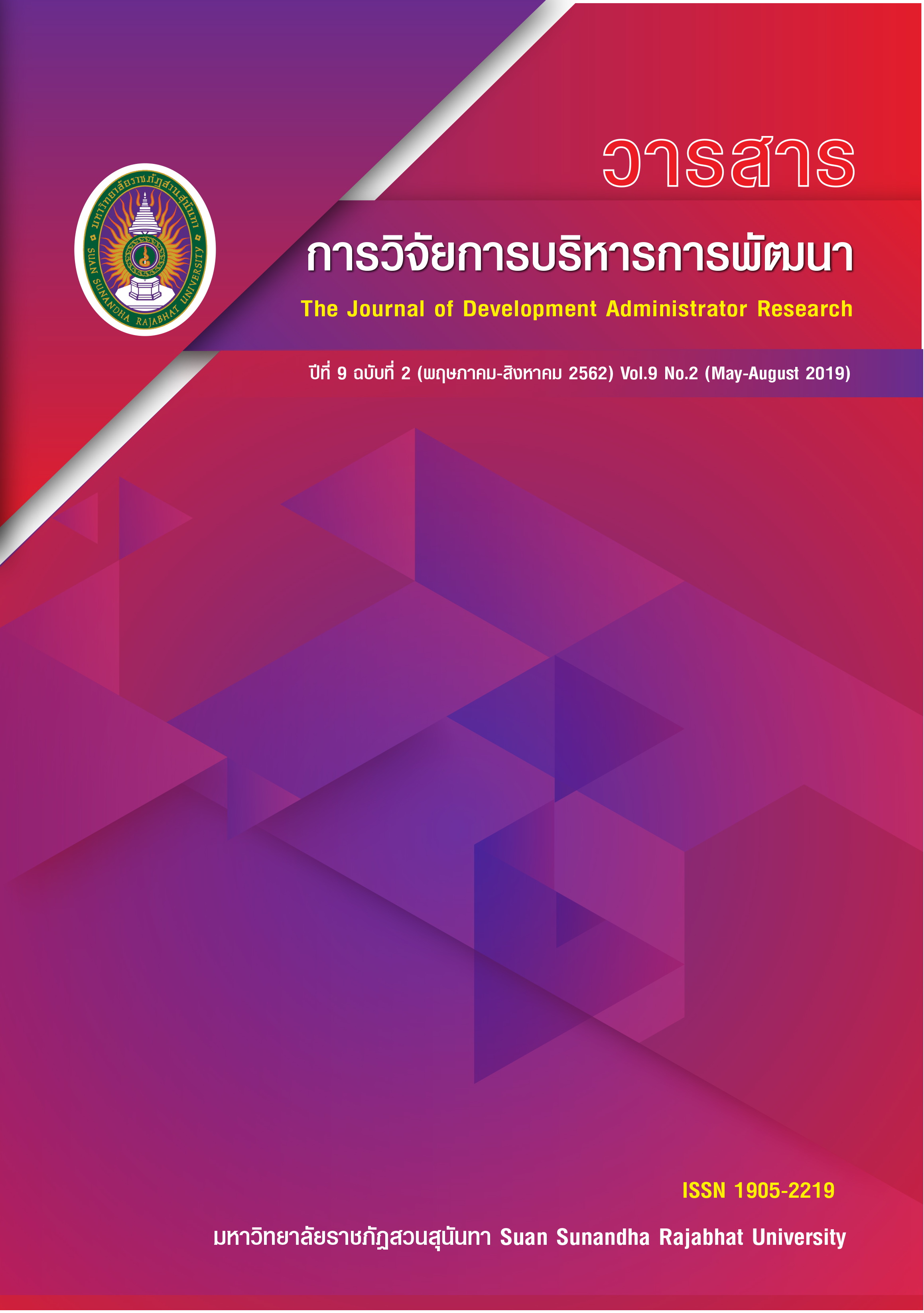ศักยภาพที่คาดหวังของธุรกิจสตาร์ทอัพที่ขับเคลื่อนด้วยความสามารถของผู้ประกอบการ ความเชื่อมั่นต่อภาครัฐ ลูกค้าที่คาดหวัง และการสนับสนุนทรัพยากร
คำสำคัญ:
ธุรกิจสตาร์ทอัพ, ความสามารถของผู้ประกอบการ, ความเชื่อมั่นต่อภาครัฐ, ลูกค้าที่คาดหวัง, การสนับสนุนทรัพยากรบทคัดย่อ
การวิจัยนี้มีวัตถุประสงค์ (1) เพื่อศึกษาระดับการรับรู้ของผู้ประกอบการในเรื่อง ความสามารถของผู้ประกอบการ ความเชื่อมั่นต่อภาครัฐ ลูกค้าที่คาดหวัง การสนับสนุนด้านทรัพยากร รวมถึงสมรรถนะและการกำกับตนเอง และระดับศักยภาพที่คาดหวังในการดำเนินธุรกิจสตาร์ทอัพ (2) เพื่อศึกษาตัวแบบปัจจัยเชิงสาเหตุที่ส่งผลต่อศักยภาพที่คาดหวังในการดำเนินธุรกิจสตาร์ทอัพ โดยกลุ่มตัวอย่าง คือ ผู้ประกอบวิสาหกิจขนาดกลางและขนาดย่อมในเขตกรุงเทพมหานครที่คาดหวังจะดำเนินธุรกิจสตาร์ทอัพต่อไปในอนาคต จำนวน 430 ตัวอย่าง
ผลการวิจัยพบว่า (1) การรับรู้ของผู้ประกอบการอยู่ในระดับมากทุกด้าน ได้แก่ ด้านความสามารถของผู้ประกอบการ ด้านลูกค้าที่คาดหวังในธุรกิจสตาร์ทอัพ ด้านการสนับสนุนทรัพยากร ด้านสมรรถนะของผู้ประกอบการ ด้านการกำกับตนเองของผู้ประกอบการ และด้านศักยภาพที่คาดหวังในการดำเนินธุรกิจสตาร์ทอัพ ด้วยค่า 3.694, 3.870, 3.516, 3.905, 3.779 และ 3.650 เรียงตามลำดับ มีเพียงด้านความเชื่อมั่นต่อภาครัฐเท่านั้น ที่มีการรับรู้อยู่ในระดับปานกลาง ด้วยค่า 3.323
(2) สำหรับการวิเคราะห์ตัวแบบปัจจัยเชิงสาเหตุที่ส่งผลต่อศักยภาพที่คาดหวังในการดำเนินธุรกิจสตาร์ทอัพ พบว่า ปัจจัยการสนับสนุนทรัพยากรมีอิทธิพลรวมมากที่สุดเท่ากับ 1.768 ซึ่งปัจจัยดังกล่าวเป็นการสนับสนุนทรัพยากรจากทางภาครัฐที่เกี่ยวข้องกับการดำเนินธุรกิจสตาร์ทอัพ อาทิ กฎหมาย ระเบียบ หรือข้อบังคับและโครงสร้างพื้นฐานทางด้านเทคโนโลยีที่เกี่ยวกับการดำเนินธุรกิจสตาร์ทอัพ รวมทั้งการสนับสนุนทางด้านการเงิน เป็นต้น รองลงมาเป็นปัจจัยความสามารถของผู้ประกอบการมีอิทธิพลรวมเท่ากับ 0.870 และปัจจัยลูกค้าที่คาดหวังมีอิทธิพลรวมเท่ากับ 0.306 เรียงตามลำดับ
เอกสารอ้างอิง
เทคซอส. (2558). ผลสำรวจเผยสาเหตุว่าทำไมอัตราล้มเหลวของ Startup พุ่งสูงถึง 90%. ค้นเมื่อ 21 กรกฎาคม 2559, จาก http://techsauce.co/news/why-startup-fail-90-percent
ศูนย์ข้อมูลข่าวสารอาเซียน. (2559). โมเดลประเทศไทย 4.0. ค้นเมื่อ 9 กรกฎาคม 2559, จาก http://www.aseanthai.net/ ewt_news.php?nid= 6100&filename=index
เอสซีบี อีโคโนมิค อินเทลเลเจนซ์ เซ็นเตอร์. (2557). กลยุทธ์มัดใจผู้บริโภค Gen Y. ค้นเมื่อ 18 กรกฎาคม 2559, จาก https://www.scbeic.com/th/detail/product/130
Aslam, S., & Hasnu, S. A. F. (2016). Issues and constraints perceived by young entrepreneurs of Pakistan. World Journal of Entrepreneurship, Management and Sustainable Development, 12(1), 50-65.
Baller, S., Dutta, S., & Lanvin, B. (2016). The global information technology report 2016: Innovating in the digital economy. Retrieved February 12, 2016, from http://www3.weforum.org/docs/ GITR2016/WEF_GITR_ Full_Report.pdf
Bandura, A. (1977). Self-Efficacy: Toward a unifying theory of behavior change. Psychological Review, 84(1), 191-215.
Bandura, A. (1986). Self-efficacy: Foundation of thought and action: A social cognitive theory. Englewood Cliffs, NJ: Prentice Hall.
Bandura, A. (1997). Self-efficacy: The exercise of control. New York: Freeman and Company.
Barney, J. B. (1991). Firm resources and sustained competitive advantage. Journal of Management, 17(1), 99-120.
Boon, S., & Holmes, J. (1991). The dynamics of interpersonal trust: Resolving uncertainty in the face of risk. Cambridge, MA: Cambridge University Press.
Cortina, J. M. (1993). What is coefficient alpha: An examination of theory and applications. Journal of Applied Psychology, 78(1), 98-104.
Fini, R., Grimaldi, R., Marzocchi, G. L., & Sobrero, M. (2009). The foundation of entrepreneurial intention. Unpublished manuscript.
Hohmann, H.-H., & Welter, F. (2005). Trust and entrepreneurship: A west-east perspective. Cheltenham, UK: Edward Elgar.
Izquierdo, E., & Buelens, M. (2011). Competing models of entrepreneurial intentions: The influence of entrepreneurial self-efficacy and attitudes. International Journal of Entrepreneurship and Small Business, 13(1), 75-91.
Jump, N. (1978). Psychometric theory (2nd ed.). New York: McGraw-Hill.
Love, B., Mackert, M., & Silk, K. (2013). Consumer trust in information sources: Testing an interdisciplinary model. SAGE Open, 2(April-June), 1-13.
Neuman, W. L. (1991). Social research methods: Qualitative and quantitative aproaches. Boston: Allyn and Bacon.
Nunnally, J. C. (1978). Psychometric theory (2nd ed.). New York: McGraw-Hill.
Rovinelli, R. J., & Hambleton, R. K. (1976). On the use of content specialists in the assessment of criterion-referenced test item validity. Amherst, MA: The University of Massachusetts.
Shapero, A., & Sokol, L. (1982). The social dimensions of entrepreneurship. Englewood Cliffs, NJ: Prentice Hall.
Shukla, B., Sharma, A., & Joshi, M. (2015). Can business incubators impact the start-up success? India perspective! SSRN Electronic Journal, 7(1), 1-35.
Sichtmann, C. (2006). The effectiveness of corporate reputation management for product innovations. Brisbane, Australia: Proceedings of the ANZMAC Conference.
Tsai, Y. C., & Cheng, Y. T. (2012). Analyzing key performance indicators (KPIs) for e-commerce and internet marketing of elderly products: A review. Archives of Gerontology and Geriatrics, 55, 126-132.
Ye, Q. (2018). New-born startups performance: Influences of resources and entrepreneurial team experiences. International Business Research, 11(2), 1-15.
ดาวน์โหลด
เผยแพร่แล้ว
รูปแบบการอ้างอิง
ฉบับ
ประเภทบทความ
สัญญาอนุญาต
บทความที่ได้รับการตีพิมพ์เป็นลิขสิทธิ์ของมหาวิทยาลัยราชภัฏสวนสุนันทา
ข้อความที่ปรากฏในบทความแต่ละเรื่องในวารสารวิชาการเล่มนี้เป็นความคิดเห็นส่วนตัวของผู้เขียนแต่ละท่านไม่เกี่ยวข้องกับมหาวิทยาลัยราชภัฏสวนสุนันทา และคณาจารย์ท่านอื่นๆ ในมหาวิทยาลัยฯ แต่อย่างใด ความรับผิดชอบองค์ประกอบทั้งหมดของบทความแต่ละเรื่องเป็นของผู้เขียนแต่ละท่าน หากมีความผิดพลาดใดๆ ผู้เขียนแต่ละท่านจะรับผิดชอบบทความของตนเองแต่ผู้เดียว




